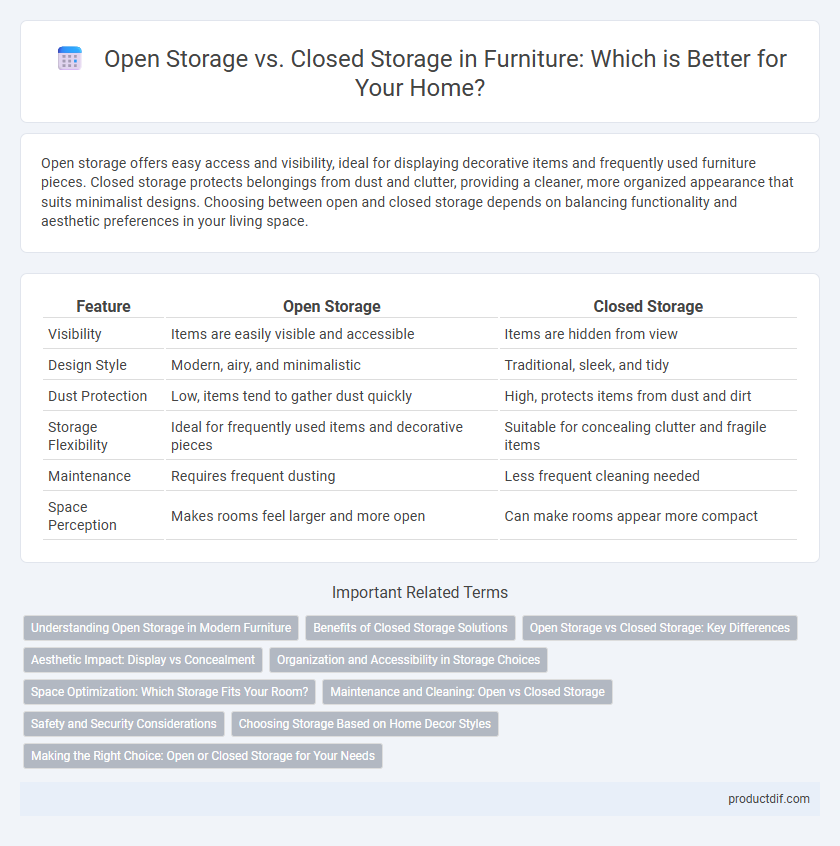Open storage offers easy access and visibility, ideal for displaying decorative items and frequently used furniture pieces. Closed storage protects belongings from dust and clutter, providing a cleaner, more organized appearance that suits minimalist designs. Choosing between open and closed storage depends on balancing functionality and aesthetic preferences in your living space.
Table of Comparison
| Feature | Open Storage | Closed Storage |
|---|---|---|
| Visibility | Items are easily visible and accessible | Items are hidden from view |
| Design Style | Modern, airy, and minimalistic | Traditional, sleek, and tidy |
| Dust Protection | Low, items tend to gather dust quickly | High, protects items from dust and dirt |
| Storage Flexibility | Ideal for frequently used items and decorative pieces | Suitable for concealing clutter and fragile items |
| Maintenance | Requires frequent dusting | Less frequent cleaning needed |
| Space Perception | Makes rooms feel larger and more open | Can make rooms appear more compact |
Understanding Open Storage in Modern Furniture
Open storage in modern furniture enhances accessibility and visual spaciousness by eliminating doors and walls, allowing items to be displayed and easily reached. This design emphasizes minimalism and functionality, making it ideal for living rooms, kitchens, and offices where frequent use and aesthetic appeal are prioritized. Materials like metal, glass, and light wood are commonly used to complement open storage units, promoting air circulation and reducing visual clutter.
Benefits of Closed Storage Solutions
Closed storage solutions offer significant benefits by protecting items from dust, dirt, and damage, ensuring a cleaner and more organized living space. These storage options enhance privacy, allowing users to conceal clutter and maintain a minimalist aesthetic. Durable materials in closed cabinets and wardrobes provide long-lasting protection, making them ideal for valuable or sensitive possessions.
Open Storage vs Closed Storage: Key Differences
Open storage offers easy access and visibility, ideal for frequently used items and decorative displays, while closed storage provides protection from dust and a clutter-free appearance, perfect for concealing less attractive belongings. Materials like glass or wood frame open shelves, contrasting with solid doors or drawers in closed units, influencing both aesthetics and functionality. Choosing between open vs closed storage depends on space organization needs, style preferences, and the balance between display and discretion.
Aesthetic Impact: Display vs Concealment
Open storage enhances aesthetic appeal by showcasing curated items, adding visual interest and personality to a space through visible shelves and compartments. Closed storage offers a sleek, minimalist look by concealing clutter and maintaining clean lines, ideal for modern, organized interiors. Selecting between open and closed storage depends on whether the design goal prioritizes decorative display or practical concealment.
Organization and Accessibility in Storage Choices
Open storage solutions enhance organization by providing immediate visibility and easy access to items, making them ideal for frequently used furniture or decorative pieces. Closed storage offers superior protection from dust and clutter concealment, promoting a cleaner appearance and safeguarding valuables. Choosing between open and closed storage hinges on balancing accessibility needs with aesthetic preferences and maintenance considerations.
Space Optimization: Which Storage Fits Your Room?
Open storage maximizes space utilization by providing easy access and visual organization, ideal for small rooms where every inch counts. Closed storage offers a clutter-free appearance, concealing items to create a minimalist and spacious feel in larger rooms. Choosing between open and closed storage depends on room size, decor style, and the need for accessibility versus tidiness.
Maintenance and Cleaning: Open vs Closed Storage
Open storage furniture requires frequent dusting and regular cleaning since items are continuously exposed to air and pollutants, making maintenance more labor-intensive. Closed storage units protect contents from dust, moisture, and pests, reducing cleaning frequency and preserving items longer. Materials like glass or laminate in closed storage also simplify surface cleaning, enhancing overall hygiene and upkeep efficiency.
Safety and Security Considerations
Open storage furniture offers easy access and visibility but poses risks for hazardous items and lacks protection against dust, dirt, and theft, making it less suitable for homes with children or valuable possessions. Closed storage options such as cabinets and wardrobes provide enhanced safety by securing contents behind doors and locks, reducing accident risks and improving security for sensitive or fragile items. Selecting between open and closed storage should prioritize the specific safety needs and security requirements of the space's occupants and stored items.
Choosing Storage Based on Home Decor Styles
Open storage complements modern and minimalist home decor styles by showcasing items and adding visual interest, while closed storage suits traditional and eclectic interiors by concealing clutter and maintaining a tidy appearance. Materials like glass and metal frames enhance open shelving in industrial-style spaces, whereas wooden cabinets with doors align with rustic or classic decor themes. Selecting storage depends on balancing aesthetic preferences with functional needs, ensuring the furniture matches the color palette and design motifs of the room.
Making the Right Choice: Open or Closed Storage for Your Needs
Choosing between open storage and closed storage depends on your lifestyle and aesthetic preferences; open storage offers easy access and showcases decorative items, while closed storage keeps clutter hidden and protects belongings from dust. For small spaces or minimalistic designs, closed storage maximizes organization with a cleaner look, whereas open storage creates an airy feel and encourages frequent tidying. Consider durability, maintenance, and functionality to align your furniture choice with both practical needs and visual appeal.
Open Storage vs Closed Storage Infographic

 productdif.com
productdif.com